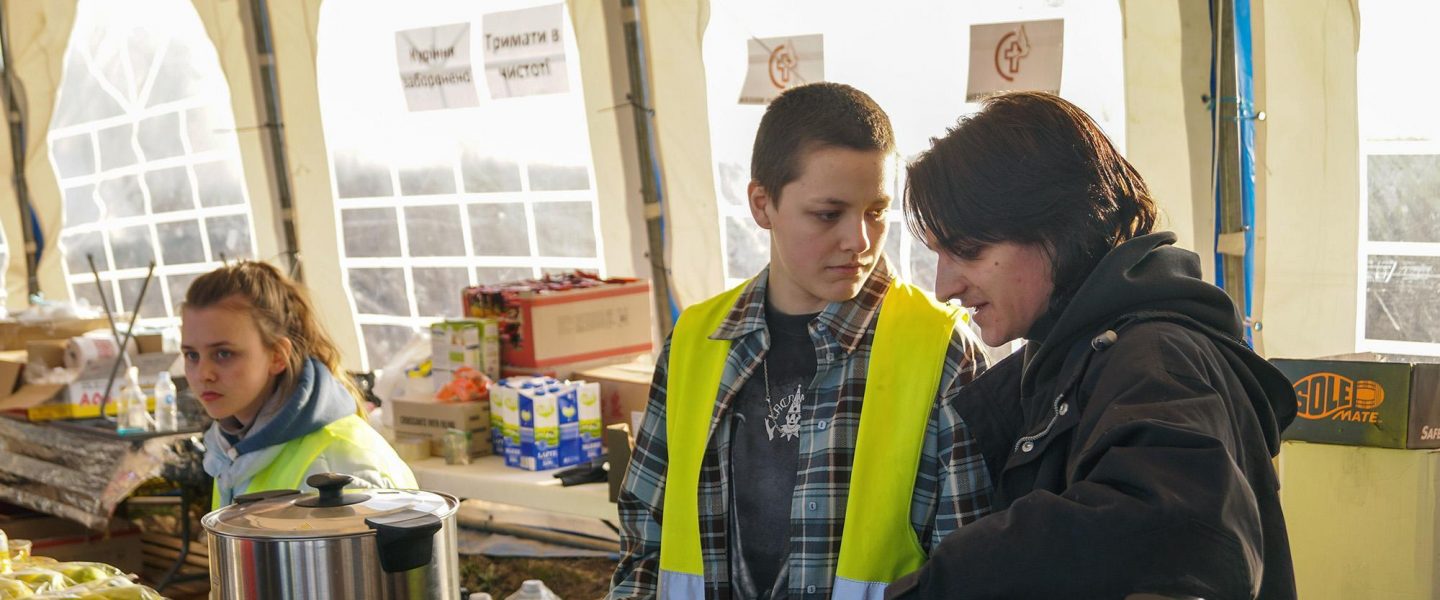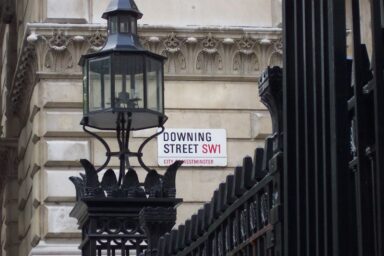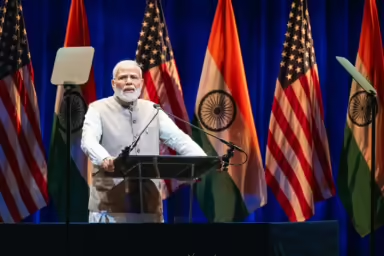Moldova, the tiny and impoverished former Soviet state immediately to Ukraine’s west, is the portal of entry to refuge for hundreds of thousands of Ukrainians fleeing the war, as well as a final destination.
Eighty-seven-year-old Alla arrived in Moldova on the night of March 22 wearing her grandson Vova’s hoodie and sweatpants, and something else less familiar.
She’d had no presence of mind to pack before the Russians started bombing Mariupol on February 24. During the following three weeks she and her family spent sheltering in a basement — in which their home was bombed, a fact Alla’s family hid from her — Vova threw away his grandmother’s only clothing: a pair of pants, a shirt, and a sweater.
“I’m in Pampers,” Alla said, her voice cracking as she recounted her story a month later, on the morning of March 23.
After escaping Mariupol in three cars, the family ended up in Congaz, a village located in Gagauzia, a Russian-speaking region of Moldova. They lodged in the hotel Gagauz Sofrasi, where Alla and her family sat on benches and chairs outside in the brilliant sun rather than resting under the pavilion-style roof of the hotel entrance. The shade reminded them too much of the basement.
On their first night, the group did not sleep; they stayed up talking with Anna Statova, the proprietor. “They wanted to express their pain, their resentment, their lack of understanding,” Statova said. They spoke of the agony over deciding to leave, and the horror — a whole family “torn apart” by Russian shelling in front of the house where they were hiding, other people killed while fetching water — that forced their decision, the same call made by millions of other Ukrainians, many of whom are also finding refuge relatively close to home in Moldova.
Nearly 5 million people — more than 10 percent of Ukraine’s prewar population — fled Ukraine in the first five weeks of the war, according to the UN Refugee Agency. Of these, at least 448,170 have arrived, like Alla and Vova, in Moldova — a poor, mostly agrarian former Soviet republic, approximately the size of the state of Maryland with a population of about 3.3 million.
So far, rather than move on, 96,612 Ukranians have elected to stay despite primitive conditions. Across the country, newly paved roads disappear into rutted, uneven plains where cars jockey to avoid the deepest ditches. But even uncomfortable travel and an uncertain future is still a relief for the refugees: They no longer face risks from bombs, checkpoints manned by Russian soldiers ready to detain or rob refugees, or endless traffic jams.
Many of those who stay go to Moldova’s capital Chişinău and regions where there are larger and more permanent refugee sites. However, around 90 percent of Ukrainian refugees in Moldova are guests in a literal sense: quartered in private homes, The New York Times reported.
Though families hosting refugees in Moldova can now apply for cash stipends from the World Food Program, it is uncertain how long Moldova can handle the burden of the crisis. In the meantime, more refugees keep coming.

Leaving Ukraine
Sixty-five percent of Ukrainian refugees entering the country come through a border town called Palanca and the nearby village Tudora. Here, humanitarian organizations gather to aid those in transit above a refugee tent site that remains nearly empty — most Ukrainians prefer to move on upon arrival in Moldova.
Refugees also find passage with the help of humanitarians like Ayat Abuznade, the 34-year-old founder of Team Humanity USA — a nonprofit organization established during the 2015 sea rescue crisis at Lesbos to help refugees from the Middle East, Asia, and Africa travel from Turkey to Greece. Team Humanity has been organizing evacuations from Ukraine, promoted through social media and word-of-mouth since Russian President Vladimir Putin’s invasion began.
As of late March, Team Humanity estimated it had driven more than 1,000 Ukrainian refugees to safety — a trip that took as long as 16 hours when the war first began. Now, the five buses shuttling up to 200 refugees per day away from conflict zones — like Mykolaiv, a beleaguered Ukrainian city on a large river north of the Black Sea, and Odesa, a bustling port on the western shores of the Black Sea that is Ukraine’s third-largest city — can do it in 10. According to Abuznade, safe routes are established with help from the North Atlantic Treaty Organization (NATO) and other organizations with access to satellite imagery.
Once they cross into Palanca, Team Humanity continues another two and a half hours to drop refugees at shelters in Chişinău. The alternative to bus travel, if refugees aren’t in private vehicles, is crossing the border on foot, an hours-long march.

Across the Border
They are first welcomed by people from varying international and local organizations. Some are Christian groups; others are concerned Moldovan citizens.
Ivan Zhelizoglo, 54, was at the border for the third time in two weeks representing the Biserica Baptistă Biblică Church in Chişinău. He has lived in Moldova all his life except for the two years when he served in the Soviet army, which left him with a distaste for Russia.
He and two other church members brought buns, bread, and religious pamphlets printed on blue, orange, and yellow paper. The pamphlets read “Point of destination” in Russian and “What time is it?” in Romanian and are distributed to the refugees. Zhelizoglo knows they are afraid and hopes to provide meaning through God.
“God, who allowed this situation to happen, who controls it, and who knows why it’s all happening… He has the goal that they come to know him,” he said. “It’s not just to scare people or evict them from their homes.”
Zhelizoglo and others from his congregation sometimes help refugees translate documents for travel or administrative purposes, and offer other material support: There are currently 31 refugees staying in a house in Chişinău owned by the church, where church members help the new arrivals adapt to life in Moldova.

Eli Hasen, also 54, came from Israel with the volunteer organization United Hatzalah, which provides medical first response in crisis situations.
Back in Israel, Hasen and six of his sons volunteer with the local fire department. “We have a fire truck parked next to our house,” he explained. “And if there’s a fire at two o’clock in the morning, we go.”
In Ukraine, he and nine other United Hatzalah volunteers drive two hours from Chişinău each day to the border. Wearing bright orange vests and impossible to miss among the others milling at the entry point, they flock to the refugees arriving on foot. Nearly always outnumbering them, they carry luggage, distribute stuffed animals, “and give some candies to the kids,” as well, Hasen said.
“We’re happy to give the kids the first smiles on their faces, apparently, in a few days of walking and leaving their homes,” he said. Hasen was touched after one four-year-old boy yelled at a minibus driver to let him back off to thank the volunteers. “He refused to get on the bus and go before he [did],” Hasen said.
These minibuses shuttle refugees to their next stop, a more structured volunteer encampment on a hill five minutes away from the border.

At the Camp
Typical Moldovan village homes of concrete and cob with tan-gray walls and corrugated metal roofs, surrounded by gardens of fruit trees and sheds sheltering stacked hay, flank the left side of the entry to Palanca when coming from the west. The refugee tent village is set up in a field on the right, the welcome center on a hill just beyond.
While Palanca was bustling with waves of winter-coat-clad refugees in the first few weeks of the war in Ukraine, today it is almost empty. The dozens of tents, prepared in case of further Russian military advance and refugee influx, were nearly unoccupied in late March.
This is not meant to be a refugee camp. Instead, it’s “a transit center,” said Alessandro Verona, medical coordinator for the European regional branch of the international nonprofit Intersos.
Besides several tables offering hot snacks and drinks, and tents and vehicles offering medical care, a motley fleet of buses move those who wish to continue their journey.

International aid organizations such as Intersos, Doctors Without Borders, UNICEF’s Blue Dots, and others are present. Volunteers from many nations — Moldova, France, Greece, Italy, the UK, the US, even Ukraine — work at the camp.
Eighteen-year-old Alexandra, who did not share her last name, left alone to come to Moldova from Odesa on the morning of March 18. She is one of the first people who greet fellow refugees once they have been driven to the Palanca encampment.
Alexandra was a bartender when the invasion began but lost her job after Odesa imposed a curfew. While she had already paid half her rent for the month, “My realtor let me down a little,” she said, speaking in Russian. “That is, he disappeared. I was left without money, without a place to live, and without work.
“I don’t live with my family, and we have not spoken in a long time. So I decided to become a refugee.”
She connected online with volunteers who drove her to a military checkpoint. She boarded a military bus to Palanca, and landed in a Russian Orthodox school in the village.
Rather than moving on immediately like most refugees, she stayed to wait for more volunteers who would help her find longer-term accommodation at a refugee center in Holland.
“If it was like it is in Europe [here], things would be better,” Alexandra said. “And so I’m striving [to get] there.”
She offers tea and snacks, and can direct people to temporary accommodations at the Palanca tent site. Sometimes Alexandra will go on one of the buses to the border and sit with the children who board.
Some of the medical services at the refugee welcome site in Palanca are overseen by Verona and Apostolos Veizis, executive director for Intersos Greece. Most people they attend to are female who arrive alone or with children. Many are young, but there are elderly and people with special needs, too.

Foremost, they provide medical first aid. “Most [who] enter here enter because of shortness of breath,” Verona said. Some have gastrointestinal issues because of the quality of food consumed while on the run; others need support for chronic diseases.
When escaping, people often forget medicine. “This happens even with people who recently had strokes or heart attacks,” he added.
Intersos also provides social services, surveying refugees to determine their vulnerabilities and recommend future aid. This information is given directly to refugees.
“Young women are very traumatized, but even children are in this condition often,” Verona said. Initial trauma can manifest in nightmares and panic attacks.
“We cannot forget that [some of] those people have been living underground for a long period of time, and there was shelling, bombing,” Veizis added. Further, Ukrainian families are separated, with the men often staying behind to fight.
“When half of the family is left behind and they don’t know whether they will find their husband alive, that’s [a] question you cannot get around,” Veizis said. This adds to the stress of an uncertain future.

Not the End
Marina Zaretskaya and her family held out in Kharkiv for about eight days before fleeing to Moldova. At first, they had not believed the rumors of an invasion and brushed off whispers that residents should get documents together to flee. It wasn’t until her sister called at around four in the morning on February 24 to tell her they were being bombed that Zaretskaya understood.
“We live up high, there are 16 floors in our building,” she said. “Imagine, right over the district, I look out of the window and I see a black sky. I was afraid, because there had never been such a black sky before. I understood later that it was obviously from an explosion.”
Zaretskaya, a psychologist who practices with the international community of therapists Symboldrama, finally left Kharkiv, piled into a car with her elderly mother, her husband, and their three children, part of a four-car convoy. They left at 6 a.m., after the city’s curfew had lifted, through streets with no working stoplights.
There was “bombing everywhere,” she said. On the city’s periphery, they encountered checkpoints of Ukrainian soldiers, who reviewed their passports and searched for weapons.
The first stop was Chernivtsi in western Ukraine, where they rested in a home provided by her godfather. From there, they tried to reach family friends in Italy via Romania, but were deterred by the traffic with endless lines of vehicles clogging the roads.
Desperate, out of ideas, and running out of money after eating out every day and sleeping in hotels every night, Zaretskaya called some of her work colleagues who told her to come to Moldova, the country where “everything was normal.” They retreated across Romania’s border on March 16 and have since been staying in a crowded — but clean — hostel-turned-sanctuary with other refugees in Chişinău.
On the Frontlines
The harrowing arrival is only the first stage in resolving the refugee crisis, as Ukrainians settle in their new homes or, as many hope for and are already doing, return home to their country.
According to a survey conducted by the UN’s International Organization for Migration, the majority of families remaining in Moldova intend to stay for only a month. Over time, however, needs are changing as people realize they may have to stay longer. Refugees are now requesting more medical services, employment support, and language courses.
In her work as a psychologist, Zaretskaya has noticed that once they settle and realize they will not soon return to Ukraine, refugees get restless and ask for work.
“They even said that it was not a matter of money. ‘Yes, we want [it] of course, but even here the first factor is psychological.’ They said so themselves,” Zaretskaya told WhoWhatWhy. “‘We are healthy women. When we sit at home, we are forced to think about the war, about how our parents are, the people who remain. Our whole home. It’s just bad thoughts like that. [With work] we can shift [our focus].’”
Veizis cautioned that people will need shelter to feel safe before other longer-term issues, such as post-traumatic stress disorder and depression, can be addressed. “[We need] to see how we can integrate them into our societies,” he said.
This is the first time Europe has offered blanket protection to refugees, Veizis said, so Ukrainians will not need to ask for asylum. The EU plan invokes a Temporary Protection Directive from 2001 for use “in the event of a mass influx of displaced persons.” The measure gives Ukrainians the right to live, travel, access education and health care, and work in the EU for at least one year, and potentially up to three.
However, Veizis pointed out, the same care is not offered to refugees from other conflicts. People fleeing “Syria and Iraq and Afghanistan … do not have the same treatment,”
he said.
“What we have been seeing in the last years at the international level is discrimination. We’ve been seeing criminalization of refugees and migrants. … People have less safe passage and less legal ways to reach safety when they need it.”



